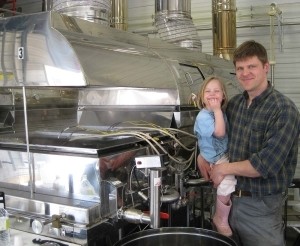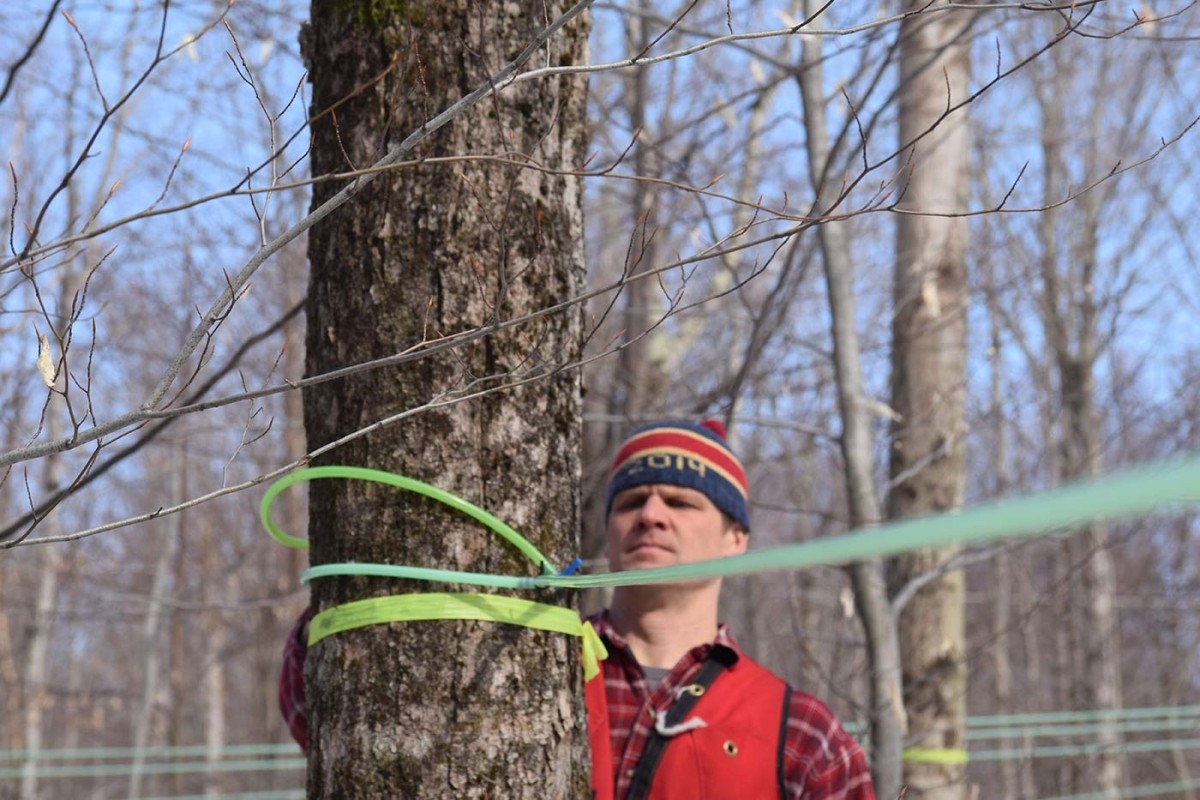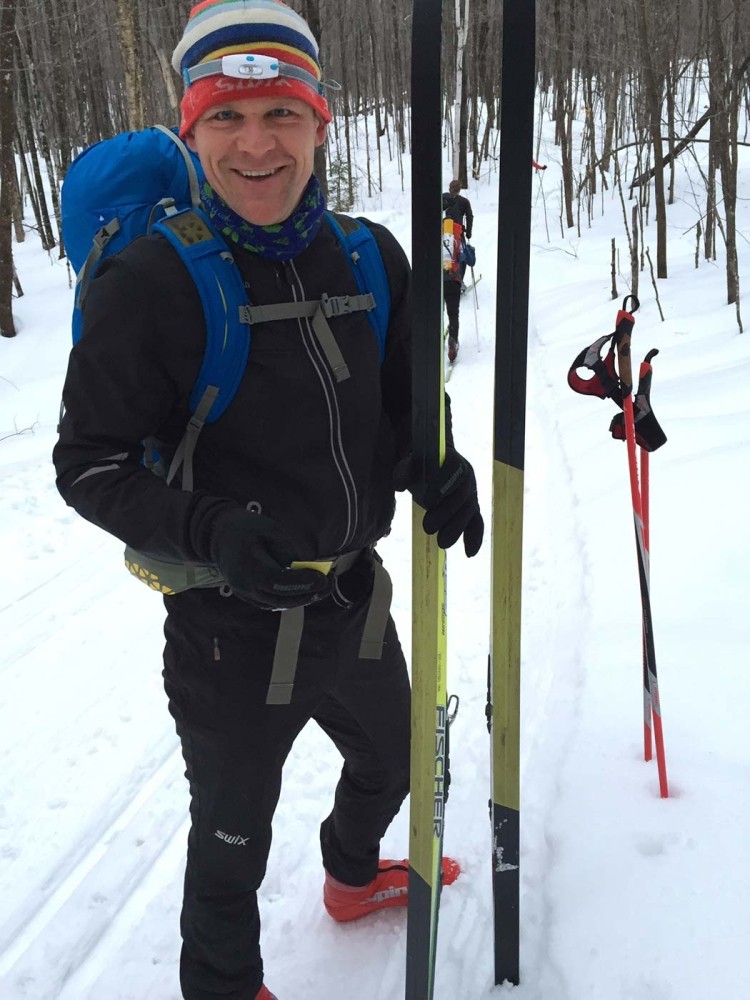
Since 1995, Mark Isselhardt has been immersed in maple sugaring research with University of Vermont Extension and the Proctor Maple Research Center. He is currently the Maple Specialist with UVM Extension and serves on several maple industry committees, as well as helping to organize the annual Vermont Maple Conferences. Mark grew up in Bennington and now lives in Elmore with his wife Kipp Bovey, a certified nurse midwife, and their children Anna and Charlie. He is vice president of the Elmore Community Trust, whose initial focus has been to preserve the local general store. Among his favorite pastimes is cross-country skiing, which he does as often as possible, including helping to coach the high school and middle school Nordic ski teams at Peoples Academy in Morrisville.
Maple is such an iconic product that has such a rich history. It’s part of the landscape wherever these trees grow, not just in Vermont. People were harvesting sap before Europeans arrived. It’s mysterious, and I think it really captivates people. They understand part of the process, but maybe not the whole process. Even people whose sole job it is to focus on this one, unique, non-timber forest product – there’s still stuff we don’t understand.
I think a lot of times the imagery of maple sugaring is really stubbornly rooted in this 19th century form, when there’s a lot of really cool stuff going on right now that looks at maple beyond just the processing time – the year-round aspect of keeping mature forests intact and the ability of trees to provide this product and also to sequester and store carbon. There’s just a lot to it that doesn’t make it onto the label, and that’s a fun part of my job to try to share that with people.
I didn’t grow up sugaring, although like a lot of kids in Vermont, one of my earliest memories is of a school trip to a sugarhouse. In high school I helped a friend’s family who sugared a little bit. And then I made a little, really terrible backyard syrup in high school with friends. I attended a pretty unique, progressive school in North Bennington until 7th grade. The Prospect School was a John Dewey-based school that really deemphasized rote learning and emphasized experiential learning and following students’ passions. That school was really focused on giving kids opportunities to be outside a lot and spend time in the woods and observe nature and be involved in unscripted play.
In high school I participated in the Governor’s Institutes, a summer academic program at UVM. Now I think there are 12 or more institutes, but back then there were only three of them – one on public issues, one on the arts, and one on natural resources. I did the public issues one and the natural resources one, which was a significant event for me in what I ended up doing for work. That two weeks was the first time I formally learned tree identification and started to understand the idea of ecology. In my senior year of high school, I took a class in natural resource management, where I was exposed to a lot of technical skills and forestry-type information.
I went to UVM and earned a bachelor’s degree in forest management. I needed a work-study job, and I ended up at the Proctor Maple Research Center. That was 1995, and I spent a few hours every week working there. That was my first experience of really understanding the maple industry and being exposed to the research. It was splitting wood at first. It wasn’t anything too technical, but it was a great experience. From then on, I had some connection to the Research Center, through work study jobs, seasonal jobs, temporary jobs, all the way up to what I’m in now, which is a research analyst and maple specialist through Extension.
The Proctor Maple Research Center, which is celebrating it is 75th anniversary, is almost a 300-acre property in Underhill whose mission is research, demonstration and education related to maple production. The land was purchased in 1946 by Governor Mortimer Proctor and donated to the University with the express purpose of doing research into maple syrup production and maple physiology. We do everything from basic research in tree physiology, the sap flow mechanism, threats to tree health, larger ecology-scale questions, climate change – all the way through the technical aspects of producing maple syrup: achieving high yields, making sure that it’s done sustainability, making sure that the product quality remains high. Everything to do with maple other than cutting it into boards, basically.
My work involves those three big buckets: sugarbush health and management, sap production and sustainable high yields, and syrup quality. The Proctor mission has been the same from the very humble beginning, when the first laboratory looked like a tool shed. Shortly after setting up that first lab, they built a sugarhouse, because for something like sugaring, the results aren’t as meaningful if the data is collected using techniques that aren’t relevant. If you collected sap in a beaker and made syrup in a beaker, and explained all these great things you learned – but only used beakers – it wouldn’t be as impactful for the sugar makers. We have close to 6,000 taps now. Close to half of that syrup is used in UVM’s dining halls. There are also some retail sales, and the remainder is sold in bulk to one of the syrup packers in the state, and that money helps fund ongoing research.
I’ve been involved with the study of maple at UVM for a long time, mostly at the Proctor Maple Research Center, and with UVM Extension for about five years. The Proctor Maple Research Center and UVM Extension are both within the College of Agriculture and Life Sciences, but administratively it’s a different unit. One aspect of the Extension job I really enjoy is engaging with high school tech centers around the state and working to get more up-to-date research-based knowledge into those programs. The curriculum is really all over the place in terms of maple. Some of the programs have really robust maple programs with their own trees and sugarhouses and even market the syrup. For others, it’s really just a couple of weeks that they talk about it.
Along with graduate student Lynn Wolfe, who was interested in this, we developed a high school student maple competition. The students learn a lot of the latest information and the basics about sugaring, and schools compete against each other to see who’s got the best skills. I’ve really been enjoying that, just trying to get that information that normally flows toward established businesses to these students. Many of them are going to be the next crop of sugar makers, and I think it’s important to make sure that they’re starting off with up-to-date knowledge.
The tech center students have been great. They’re engaged in the information. They soak it up. And it’s really impressive to see kids who maybe have a little sugaring operation on the side or a family operation, and they really get into it and do the whole process, from tapping trees to bottling and marketing syrup. Those are skills that are going to pay off for them even if they don’t go into sugaring.
One example of our research is the “long-term project,” where we’re in our 10th year of tapping trees in one stand with no previous history of tapping, with mature trees sized appropriately for sugaring. We broke that stand into three treatments: one no tap, one tapped and using “gravity sap collection,” and one tapped with high vacuum – sort of the latest, highest extraction method. And we’re looking at those trees over the long term to see what the impacts of that increased extraction are on the health of the tree. Inevitably, the first question people ask when you tell them we are able to take twice as much sap as we could previously is, “What does that mean to the tree?” It’s not an acute stress. We don’t see a tree dying as a result of that change. But we want to make sure that over the long term, the tree is able to accommodate that. We’re in our 10th year, and so far, we aren’t seeing significant differences between those three treatments.
Anyone can get into maple. You don’t have to have multiple generations of maple producers. There are some people who do it as a hobby, and that’s great. We get a lot of calls and provide a lot of outreach to people who are just getting into it. There are some big operations, as well. We have a few producers in the state that have 100,000 taps, which used to be unheard of. At the end of the day, if you’re putting syrup in a bottle and selling it, you have to meet the minimum standards. This includes understanding how to ensure only correct density syrup reaches the consumer as well as how to taste it and make sure the flavor meets the standard. Ensuring that Vermont continues a proud tradition of making high quality syrup is what’s important, not the size of a given operation. And that’s part of my job – making sure people understand how to make high quality pure maple syrup.
Clearly the unknown of where the climate is headed is a big concern. With sugaring specifically, when we talk about climate change, I really try to make sure we talk about things in terms of time scales. So there are things happening right now, then there are threats and concerns sort of in the middle term and in the long term. Presently, probably the biggest threats are really anomalous high temperature events during the sugaring season. We had one of those in 2012, where in March we had five days in the mid- to upper-70s, and it had a significant impact on yield and the sap quality. There’s really no technology that is going to allow you to get through that. So, if the forces that contributed to make that happen become more common, that would be a concern, and it is presently a concern. Along with that, big weather events, really flashy storms, that sort of thing are also a concern. In the middle term, I’d say concerns include invasives that are crowding out native species, specifically maple regeneration, making it harder for sugar maples to compete. Longer term, is sugar maple going to be as competitive on the landscape as it is now? The further you get out, the more uncertainty there is and the weaker the models are.
When we survey sugar makers, they are concerned about climate change, but they’re also optimists and continue to move forward. Sugaring is really a mix of agriculture and forestry. Essentially, you’re focused on growing trees to be able to collect sap, so you are going to manage for a narrower range of species while making sure there is enough diversity in species, structure, and age to ensure healthy, resilient forests. A big part of my job is sharing research-based knowledge to those charged with ensuring sugarbush health. I think that’s going to mitigate some of the species migration, whereas maybe a stand that is less actively managed might be more likely, in the very long term, to see that shift in species. Maple syrup is also made all around the country and in Canada, so there’s a wide range of climates in which maple syrup is produced, and some of them may be more prone to these dramatic high temperature events, for instance, than others. So you might get a different average response from sugar makers living at the perimeter of where syrup is produced than in the heart of where it is produced.
It is amazing to see how far maple has come, especially in Vermont where it is just so iconic. The growth of the maple industry didn’t happen by accident. People really had to work and be creative in order to realize the gains maple has enjoyed over the last 25 years. It feels hopeful but there are real threats moving forward. By and large, sugar makers are incredibly inventive and willing to share experiences, good and bad. It makes for a really fun group to work with.



